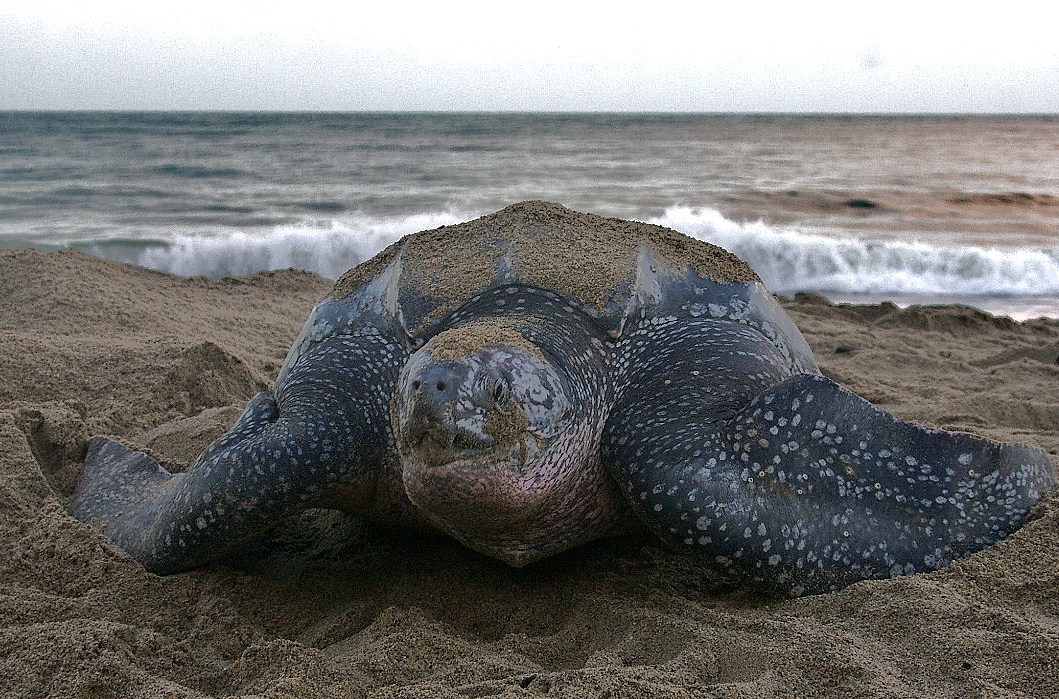Official State Marine Reptile of California
In 2012 California designated the endangered Pacific leatherback sea turtle (Dermochelys coriacea) as the official state marine reptile and October 13 as Pacific Leatherback Sea Turtle Conservation Day. California also recognizes the desert tortoise as a state symbol. All State Reptiles
Pacific Leatherback Sea Turtle Facts
The leatherback is the largest turtle, and one of the largest living reptiles in the world. Adult leatherback sea turtles can weigh up to 2000 pounds and can reach a length of 8 feet.
The leatherback is the only sea turtle without a hard, bony shell. The top shell (carapace) is a leathery, oil-saturated connective tissue. Leatherback turtles are open-ocean animals, but they also forage in coastal waters and lay their eggs on sandy beaches.
Assembly Bill No. 1776 CHAPTER 591
[ Approved by Governor September 26, 2012 ]
LEGISLATIVE COUNSEL'S DIGEST
AB 1776, Fong. State government: Pacific leatherback sea turtle.
(1) Existing law establishes the state flag and the state’s emblems, including, among other things, the poppy as the official state flower, the California redwood as the official state tree, and the California desert tortoise as the official state reptile.
This bill would establish the Pacific leatherback sea turtle as the official state marine reptile.
(2) Existing law designates certain periods of time for specified purposes of celebration or recognition.
This bill would designate October 15, 2013, and every October 15 thereafter, as Pacific Leatherback Sea Turtle Conservation Day. The bill would encourage public schools, state and federal agencies, nongovernmental agencies, fishers, coastal tour operators, and other interested stakeholders to engage in certain activities, as specified.
Bill Text
The people of the State of California do enact as follows:
SECTION 1. The Legislature finds and declares all of the following:
(a) California is a coastal state that is dedicated to the protection of ocean resources, fisheries, and marine wildlife.
(b) Sea turtles, fish, seabirds, and marine mammals are a central component of California’s natural heritage and marine biodiversity.
(c) The Legislature acknowledges that the Pacific leatherback sea turtle population has experienced a catastrophic decline over the past two decades and might be on the verge of extinction.
(d) The Legislature further acknowledges that Pacific leatherback sea turtles are among the most imperiled of any sea turtle population in any ocean basin on Earth and that populations of the Pacific leatherback sea turtle, a 100-million-year-old species that outlived the dinosaurs, have declined by approximately 90 percent in the last 25 years.
(e) Pacific leatherback sea turtles foraging off the coast of California are part of a distinct Western Pacific breeding stock that nests on beaches in Indonesia, Papua New Guinea, and the Solomon Islands.
(f) California’s coastal waters are high-use foraging areas for summer nesters from this critically endangered population of Pacific leatherback sea turtles, according to the National Marine Fisheries Service.
(g) Satellite tracking conducted over the past decade has determined that after nesting hundreds of individual Pacific leatherback sea turtles swim more than 6,000 miles over 10 to 12 months to cross the Pacific to feed on jellyfish in California coastal waters every year.
(h) The Pacific leatherback sea turtles’ trans-Pacific migration involved multiple years of migrating between California coastal waters during the summer and lower latitude wintering areas without returning to Western Pacific nesting beaches.
(i) These movements and foraging strategies underscore the importance of and the need for ecosystem-based management and coordinated Pacificwide conservation efforts.
(j) The Legislature supports efforts to recover and preserve the Pacific leatherback sea turtle population in oceanic feeding and migration areas, which are identified as important strategies for their continued survival.
(k) On February 26, 2012, the National Marine Fisheries Service designated more than 16,000 square miles of California’s coastal waters, and a total of nearly 42,000 square miles along the United States West Coast, as critical habitat to protect high-use foraging areas and primary prey species for the endangered Pacific leatherback sea turtle under the federal Endangered Species Act.
SEC. 2. Section 422.5 of the Government Code is amended to read:
422.5. (a) The California desert tortoise (Gopherus agassizii) is the official state reptile.
(b) The Pacific leatherback sea turtle (Dermochelys coriacea) is the official state marine reptile.
SEC. 3. Chapter 29.5 (commencing with Section 7593.5) is added to Division 7 of Title 1 of the Government Code, to read:
CHAPTER 29.5. Pacific Leatherback Sea Turtle
7593.5. (a) October 15, 2013, and every October 15 thereafter, is hereby designated as Pacific Leatherback Sea Turtle Conservation Day.
(b) The Legislature encourages California public schools to include Pacific leatherback sea turtles in their teaching lessons and curriculum whenever possible.
(c) The Legislature encourages state and federal agencies, nongovernmental agencies, fishers, coastal tour operators, and other interested stakeholders to establish and participate in a statewide, voluntary Pacific leatherback sea turtle watch to record sightings of the Pacific leatherback sea turtle in California and West Coast waters.
(d) The Legislature encourages state and federal agencies to build cooperative relationships with the Western Pacific island nations where Pacific leatherback sea turtles return to nest in order to increase awareness and conservation of this critically endangered species.
(e) The Legislature urges state and federal agencies to take proactive conservation measures and prevent further threats to Pacific leatherback sea turtles and their habitats.

